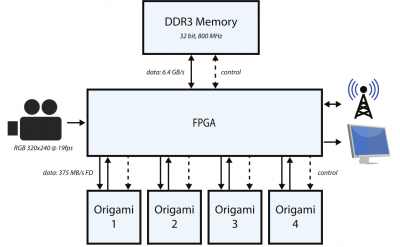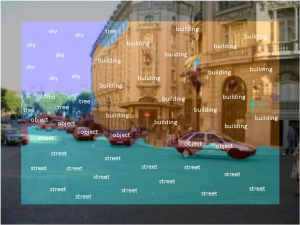Difference between revisions of "FPGA System Design for Computer Vision with Convolutional Neural Networks"
From iis-projects
m (→Description) |
m |
||
| Line 7: | Line 7: | ||
While we have successfully explored accelerating the convolution step taking up 80% to 90% of the overall compute time with a small accelerator ASIC ("Origami") [3], we would like to build a more complete system on a FPGA and further improve the accelerator. This is where you come in. We have several aspects which we would like to explore: porting the Origami accelerator to run efficiently on the FPGA, hardware/software-co-design configuring memory and DMA controllers, building small IP cores to finish the processing pipeline (activation, pooling), and completing the system by connecting a camera or loading a video stream and displaying the results. | While we have successfully explored accelerating the convolution step taking up 80% to 90% of the overall compute time with a small accelerator ASIC ("Origami") [3], we would like to build a more complete system on a FPGA and further improve the accelerator. This is where you come in. We have several aspects which we would like to explore: porting the Origami accelerator to run efficiently on the FPGA, hardware/software-co-design configuring memory and DMA controllers, building small IP cores to finish the processing pipeline (activation, pooling), and completing the system by connecting a camera or loading a video stream and displaying the results. | ||
| − | ===Status: | + | ===Status: In Progress=== |
| + | Kevin Luchsinger | ||
: Looking for (1 or 2) Master or (1 to 3) semester project students (work load will be adjusted) | : Looking for (1 or 2) Master or (1 to 3) semester project students (work load will be adjusted) | ||
: Contact/Supervision: [[:User:Lukasc | Lukas Cavigelli]] | : Contact/Supervision: [[:User:Lukasc | Lukas Cavigelli]] | ||
| − | [[Category:Hot]] [[Category:Digital]] [[Category:System Design]] [[Category: | + | [[Category:Hot]] [[Category:Digital]] [[Category:System Design]] [[Category:In progress]] [[Category:Semester Thesis]] [[Category:Master Thesis]] [[Category:Lukasc]] |
<!-- | <!-- | ||
===Status: {Available, Reserved, In Progress, Completed}=== | ===Status: {Available, Reserved, In Progress, Completed}=== | ||
Revision as of 22:53, 13 March 2016
Contents
Description
Imaging sensor networks, UAVs, smartphones, and other embedded computer vision systems require power-efficient, low-cost and high-speed implementations of synthetic vision systems capable of recognizing and classifying objects in a scene. Many popular algorithms in this area require the evaluations of multiple layers of filter banks. Almost all state-of-the-art synthetic vision systems are based on features extracted using multi-layer convolutional networks (ConvNets), nowadays even outperfoming humans on object classification tasks [1,2].
While we have successfully explored accelerating the convolution step taking up 80% to 90% of the overall compute time with a small accelerator ASIC ("Origami") [3], we would like to build a more complete system on a FPGA and further improve the accelerator. This is where you come in. We have several aspects which we would like to explore: porting the Origami accelerator to run efficiently on the FPGA, hardware/software-co-design configuring memory and DMA controllers, building small IP cores to finish the processing pipeline (activation, pooling), and completing the system by connecting a camera or loading a video stream and displaying the results.
Status: In Progress
Kevin Luchsinger
- Looking for (1 or 2) Master or (1 to 3) semester project students (work load will be adjusted)
- Contact/Supervision: Lukas Cavigelli
Prerequisites
- VLSI 1 lecture (or otherwise basic knowledge of VLSI design)
- Motivation for FPGA design and computer vision.
Character
- 80%-90% FPGA design
- 10%-20% Theory
Professor
References
- Imagenet Large Scale Visual Recognition Challenge 2015. link
- K. He, X. Zhang, S. Ren, J. Sun, “Delving Deep into Rectifiers: Surpassing Human-Level Performance on ImageNet Classification,” arXiv:1502.01852, 2015. link
- L. Cavigelli, D. Gschwend, Ch. Mayer, S. Willi, B. Muheim, L. Benini, “Origami: A Convolutional Network Accelerator,” in Proceedings of the 25th Edition on Great Lakes Symposium on VLSI, 2015. link

